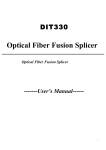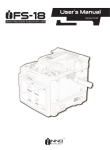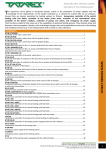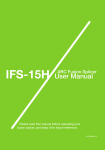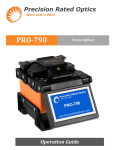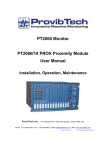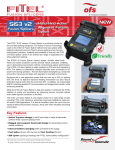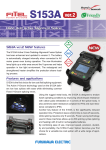Download SAT-17S fiber fusion splicer user`s manual
Transcript
Instruction Manual FUSION SPLICER SAT-17S Your are highly recommended to read the instruction manual carefully before operation. Do follow all safety instructions and warnings covered in this manual. Take the manual for safekeeping. You are hereby well-informed that there may emerge edited version of the manual without extra notice. For further reference you are advised to contact us by email: [email protected] ; or contact your customer representative directly. Contents: Warnings & Cautions ................................................................................................................................... 3 1. Introduction ........................................................................................................................................... 6 2. Features...................................................................................................................................................... 6 3. Technical Specifications ............................................................................................................................ 7 4. Panel and Interface Instructions ............................................................................................................. 7 4.1 Instrumental interface .................................................................................................................... 7 4.2.1 Keyboard .............................................................................................................................. 8 4.2.2 Key definitions ...................................................................................................................... 9 4.3 Operation menu ............................................................................................................................ 10 4.3.1 Standby menu ..................................................................................................................... 10 4.3.2 Main menu .......................................................................................................................... 10 4.3.3 Other menus ....................................................................................................................... 11 5. Operation Instructions ........................................................................................................................... 12 5.1 Power on/off ................................................................................................................................... 12 5.2 Start splicing .................................................................................................................................. 12 5.3 Heating ........................................................................................................................................... 12 5.4 Reset ............................................................................................................................................... 12 5.5 Discharge ....................................................................................................................................... 12 5.6 X/Y field change ............................................................................................................................ 12 5.7. Up, down, left and right ............................................................................................................... 12 5.8 Menu keys ...................................................................................................................................... 12 5.9 Confirm and exit ........................................................................................................................... 12 5.10 LCD brightness control .............................................................................................................. 13 5.11 Time setting .................................................................................................................................. 13 5.12 Relevant splicing mode operations ............................................................................................ 13 5.12.1 “Select Splicing Mode” .................................................................................................... 13 5.12.2 Create a new splicing mode ............................................................................................. 14 5.13 Splicing results ............................................................................................................................ 15 5.13.1 Enter splicing results storage page ................................................................................. 15 5.13.2 View and erase splicing records ...................................................................................... 16 5.14 Electrode discharge times ........................................................................................................... 17 6. Splicing Operations................................................................................................................................. 18 6.1 Placing protection sleeve over optical fiber ................................................................................ 18 6.2 Stripping and cleaning optical fiber ............................................................................................ 18 6.3 Fiber Cleaving ............................................................................................................................... 19 6.4 Loading optical fiber to splicer .................................................................................................... 21 6.5 Splicing ........................................................................................................................................... 22 6.5.1 Splicing operation, select different splicing modes.......................................................... 22 6.5.2 Change splicing mode ................................................................................................................ 22 6.5.3 Start splicing ....................................................................................................................... 23 7. Heating operation ................................................................................................................................... 26 -1- 8. Discharge correction ............................................................................................................................... 27 9. Splicing parameter specification............................................................................................................ 28 10. Requisites for fiber splicing .................................................................................................................. 29 11. FAQ and Trouble-Shooting .................................................................................................................. 29 11.1 Power supply................................................................................................................................ 29 11.2 Splicing operation........................................................................................................................ 30 11.3 Heating operation ........................................................................................................................ 31 12. Maintenance .......................................................................................................................................... 32 12.1 Cleaning of V shaped groove ...................................................................................................... 32 12.2 Cleaning of pressure foot for optical fiber ................................................................................ 32 12.3 Cleaning of goggles of splicer ..................................................................................................... 32 12.4 Cleaning of objective lens ........................................................................................................... 33 12.5 Maintenance of cutting tool ........................................................................................................ 33 -2- Warnings & Cautions SAT-17S has been specially designed for splicing optical fibers in telecommunications. Any attempt to use this equipment for other applications is not recommended. Aitelong Tech attaches profound consideration to user’s personal safety, hence electric shock, fire or any personal injury caused by misoperation is least expected. On condition of the under-mentioned dysfunction, you are advised to disconnect the AC power cord from the AC adapter and remove the battery from the equipment immediately, otherwise personal security and equipment safety may be endangered. Fuming, bad smell, unusual noise, or over-heat;. Liquid or foreign matter falls inside splicer; Damage or drop occurs. Please refer to our service center for repair on the above occasions and fire or fatal consequences injury may be the consequences caused by continuing use. Please use the original AC/DC adapter or battery charger supplied by Aitelong Tech. Using any improper and non-authorized power source may cause fuming, electric shock or equipment damage, also may result in fire, personal injury or death. Please employ the supplied AC power cord. Do not place heavy objects on the AC power cord. Fuming, electric shock or equipment damage may be caused by improper or non-authorized power cord, even worse, bringing about personal injury or fatal consequences. Never operate the splicer under the existence of flammable liquids or vapors and the electrical arc may cast the splicer at risk of fire or explosion if operated under such occasion. Do not use compressed gas or canned air to clean the splicer. They may contain flammable materials and could be igniting the splicer during the electrical discharging operation. 3 Do not touch the electrodes when the splicer is in operation. The electrodes generate high voltage and high temperatures that may cause a severe shock or burn. Turn the splicer off and disconnect the AC power cord before replacing the electrodes. Safety glasses should always be worn during optical fiber preparation and splicing operation. Optical fiber fragments can be extremely dangerous if it comes into contact with the eye, skin, or has been ingested. Power source recommendations Proper AC power source is AC100-240V, 50-60Hz. Check the AC power source before use. Proper DC power source is DC10-12V. Improper AC or DC power source may cause fuming, electric shock or equipment damage and may results fire, personal injury or death. Do not supply power or use splicer under AC generator. Do not short-circuit the terminals of AC adapter and battery. Excessive electrical current may cause personal injury due to fumes, electric shock and equipment damage. Do not touch the splicer AC power cord and AC plugs with wet hands. These may result electric shock. Do not operate splicer nearby hot objects, in hot temperature environments, in dusty/humid atmospheres or when water-condensation is present on the splicer. These may result electric shock, splicer malfunction or poor splicing performance. Do not charge battery with other methods than instructed. Do not discard battery into an incinerator or fire. Do not charge or discharge battery near a flame or under direct sunlight. Do not excessively shake or jar the battery. If battery leaks of liquid residue, be careful handling the battery and make sure the liquid does not contact with in skin or eyes. If liquid contact with skin or eyes, please wash skin or eyes thoroughly and ask for nearest hospital service immediately. Call our service center for battery replacement. 4 Do not place battery on top of AC adapter during the charging. Before using the shoulder belt of carrying case, please check the belt and hooks’ condition. Carrying the case with a damaged or non-functional shoulder belt may break the belt or come off and result personal injury or equipment damage. Do not store splicer in any area where temperature and humidity are extremely high, otherwise it may result equipment failure. Do not touch thermal shrinkage tub or tube-heater during heating or immediately after completion of heating. Their surfaces are very hot, and any touching may result skin burn. Do not place the splicer in an unstable or unbalanced position. The splicer may shift or lose balance, and it will cause the splicer to fall down. Unexpected personal injury or equipment damage may be resulted. The splicer is precision adjusted and aligned. Do not let splicer to receive a strong shock or impact. Unexpected equipment failure may result. Use supplied carrying case for transportation and storage. The carrying case protects the splicer from damage, moisture, vibration and shock during storage and transportation. Please follow the instructions for electrodes replacement. Use only specified electrodes. Set the new electrodes in the correct position. Replace the electrodes must in a pair. Ignore or misunderstanding to follow the above instructions may cause unusual arc discharge. It can result equipment damage or degradation in splicing performance. Do not use any chemical other than pure alcohol (99% or greater) to clean the objective lens, V-groove, mirror, LCD monitor and other parts of the splicer. Otherwise blurring, discoloration, damage or deterioration may result. The splicer requires no lubrication. Oil or grease may degrade the splicing performance and damage the splicer. The equipment must be repaired or adjusted by an authorized technician or engineer. Incorrect repair may cause fire or electric shock. If any problems occurred, please contact your nearest sales agency. 5 1. Introduction The SAT-17S Fashion Splicer was designed and made by refined structural technology, high precision positioning technology, fast and efficient image processing technology and accurate alignment technology; it can stably, quickly and automatically achieves optical fiber splicing. The typical splicing time of SAT-17S is in 9 seconds. It also offer various observation modes function; using 5.1 inch large LCD screen, user can observe optical fiber splicing in different conditions. It is compact, light, and very suitable for field work. It’s featured in simple operation, fast splicing speed, small splicing loss, and many unique functions, especially suitable for optical fiber cable works and maintenance in telecommunications, broadcasting, railways, petrochemical, power, military, public security and other communication fields, as well as teaching and scientific research in research institutes. In order to properly use the equipment to complete splicing operation, please read this manual carefully before use. 2. Features Small, durable, and easy to carry Large-screen LCD color display Automatic screen power off to extend battery life Operating Tips and Suggestion prompts on the operation menu Automatically change the operating direction Various built-in splicing and heating modes (can be set) Much wider splicing applications : Bare fiber and bare fiber Flat cable and flat cable Flat cable and connector Flat cable and pigtail 6 3. Technical Specifications Applicable Fibers Average Loss SM (single mode), MM (multi-mode), DS (dispersion), NZDS (non-zero dispersion),BIF/UBIF 0.02dB(SM), 0.01dB(MM), 0.04dB(DS), 0.04dB(NZDS), 0.02 BIF/UBIF Return Loss better than 60dB Typical Splicing Time Typical Heating Time 9s 28s Fiber Aligning Fiber Diameter Cutting length Magnification Image display Core alignment and cladding alignment Cladding diameter 80~150μm Coating diameter 100~1000μm 10~16mm (coated optical fiber diameter <250μm) 16mm (coated optical fiber diameter 250~1000μm) X or Y, magnify 310X X and Y, magnify 155X High-performance 3.7’’ 640*480 LCD, to provide clear and detailed images Tensile test Standard 2N Heat-shrinkable tubing 60mm, 40mm, 20mm or other types Battery capacity 250 times (splicing and heating) charging time: about 3h (can be used while charging) Battery life 300~500 charging cycles Electrode life Typical 3,000 times, and replaceable External interface Mini USB Power supply Working environment Built-in lithium battery: 11.1V AC/DC adapter input: AC 100-240V output: DC 13.5V/5.0A Temperature: -10℃~+50℃ humidity: 95% RH (40℃ non-condensing) altitude: 0~5000m Dimensions L×W×H=150×152×155 (mm) Weight 1.8kg (without battery), 2.3kg (with battery) 4. Panel and Interface Instructions 4.1 Instrumental interface 7 Fig.4.1.1 Fig.4.1.2 The top right corner on Fig. 4.1.2 is the USB interface, while the lower right corner is the power input which use to connect with AC/DC adaptor. 4.2 Keyboard and key definitions 4.2.1 Keyboard 8 Fig. 4.2.1 Fig. 4.2.2 Fig. 4.2.3 4.2.2 Key definitions Start/stop Start splicing Up Reset Down Heating Left X/Y field change Right Discharge Confirm Exit Menu 9 4.3 Operation menu 4.3.1 Standby menu Fig.4.3.1 4.3.2 Main menu Fig. 4.3.2 There is 4 sub-menus under the Splicing menu (section 1), it includes: (1) Select splicing mode There is a list of modes under the Select splicing mode menu, user can choose one of splicing mode as current operating mode, and allow user to modify and redefine its specific parameters of each mode to meet user’s requirements. (SAT-17S has 8 preset 10 splicing modes as factory default.) (2) Select heating mode There is a list of modes under the Select heating mode menu, user can choose one of heating mode as current operating mode, and allow user to modify and redefine its specific parameters of each mode to meet user’s requirements. (SAT-17S has 8 preset heating modes as factory default.) (3) ARC calibration The ARC Calibration mode need be running when the operating environment have a big change, like the temperature, humidity or the elevation. To change the shifting discharge center and the intensity of discharge to make sure the splicer working well. (4) Splicing option In the Splicing option menu, you can set more splicing parameters. (5) Storage menu Splicing results are recorded and stored under this menu, user can optimizing splicing parameters according to historical splicing results. 4.3.3 Other menus Besides the Splicing menu, there have 3 more sections of menus and each of section comes with variety sub-menus in order to offer user to do more settings. They are Section 2: Setup menu; Section 3: Maintenance menu 1; and Section 4: Maintenance menu 2. The Section 1 Splicing menu is the often use menu; Setup menu allow user set language, LCD direction, power saving and other settings; in Maintenance menu 1 and Maintenance menu 2, user can operate electrode maintenance, discharge correction, motor drive and other maintenance operations. The detail of each menu is 11 on the following chapters. 5. Operation Instructions 5.1 Power on/off Power on: Hold button for about 1s until the yellow indicator LED on the operation panel turns on. The splicer will doing Self-Check during company’s LOGO showing on the screen, after that the spilicer will turn to Standby Menu if it passed system Self-Check. Power off: Hold button for about 3s until the red LED beside the key panel turns on, the splicer will shut down after user release it. 5.2 Start splicing Press to start optical fiber splicing. 5.3 Heating Press in any menu for heating. 5.4 Reset Press in any menu for reset. 5.5 Discharge Press in any menu for discharge. 5.6 X/Y field change Press in the splicing standby menu for field change. 5.7. Up, down, left and right Press in the selection menu for corresponding operations. 5.8 Menu keys Press under the standby menu to enter the main menu 1 (i.e. the splicing menu page). 5.9 Confirm and exit Press and for corresponding operations according to interface prompts. 12 5.10 LCD brightness control Press in the power saving setup menu to increase LCD brightness and press to decrease LCD brightness. 5.11 Time setting The “calendar setup” option is under the maintenance menu 1. Please enter and set the current date as follows: Fig. 5.11 5.12 Relevant splicing mode operations 5.12.1 “Select Splicing Mode” (1) Enter “Select Splice Mode” menu under the splicing menu, as shown below. Fig. 5.12.1.1 13 (2) Selected splicing mode will be the current operating mode for the splicer, and it will be high-light in red font; while other unselected modes will be in black font. The prompts operations for the splice mode setting is on the down-left of screen. Use button to move the cursor, and then press to select. and you can operate under the select 、edit、 (3) Select a splicing mode, press restore to default, delete menu. As follows: Fig. 5.12.1.2 (4) Press to edit, press or and you can change with button . 5.12.2 Create a new splicing mode (1) Select an empty mode under the Select Splicing Mode and press the new splicing mode. As follows: 14 to edit Fig.5.12.2.1 (2) Enter the Default Splicing Mode and select the splicing mode you need/ 5.13 Splicing results Splicing results will be automatically stored for each splice operation, user can view and erase splicing results from memory space. The operation method as blow: 5.13.1 Enter splicing results storage page (3) Select and enter the “ Memory” menu under the splicing menu, as shown below. Fig. 5.13.1.1 15 (4) Press to enter “splice results” menu, and user will enter the list of splice records; as shown below Fig. 5.13.1.2 5.13.2 View and erase splicing records (1) Select a group of records and press to view such records under “splice result” menu, under this menu, user can check the detail of each splice operation; information includes: as shown below. Fig. 5.13.2.1 16 (2) Select and enter “Clear Memory” menu under the “Memory Menu”, as shown below. Fig. 5.13.2.2 Press to remove all splicing records. 5.14 Electrode discharge times Enter the maintenance menu 1, select “ARC Calibration” option, and press enter the menu, as shown below. Fig. 5.14 17 to The menu will display current total discharged times. Press opreation of discharge counter, and press to do zero clearing to return to the precious page. 6. Splicing Operations 6.1 Placing protection sleeve over optical fiber The above is one side of optical fiber which used for splicing, please place protection sleeve over optical fiber before stripping, cleaning, and splicing of fiber, unless user has other protection methods. 6.2 Stripping and cleaning optical fiber Stripping optical fiber: Strip outer coating 30 to 40 mm from its tip with a stripping tool. Cleaning: Clean the optical fiber with alcohol impregnated gauze or lint-free tissue thoroughly. Note: Each cotton ball can only be used once. Do not repeatedly use. 18 Stripping Cleaning Note: Please use a high quality alcohol, greater than 99% pure. 6.3 Fiber Cleaving (1) Ensure that the sliding panel with blade has slid to the user’s side before cleaving optical fiber, and then open small and large sheath clamps. 19 (2) Align the optical fiber coating layer edge to appropriate scale mark, place optical fiber into oriented rolling groove, and confirm that bare optical fiber is vertically placed on the rubber pad. (3) Close small sheath clamp and large sheath clamp, quickly push the sliding plate with blade to the other side, and finish optical fiber cleaving. (4) Open large sheath clamp, then open small sheath clamp while holding optical fiber by another hand, flick off fragmentary optical fiber with fingers, and carefully remove the optical fiber from cleaver. Note: optical fiber sections after cutting must keep off any other objects, so as to guarantee splicing quality. 20 6.4 Loading optical fiber to splicer (1) Open wind protector and sheath clamps on left and right sides of splicer. (2) Place prepared optical fiber onto v-groove so that the optical fiber tip is located between the v-groove edge and tip of electrode. If optical fiber coating has some curl, place optical fiber and make its curve is turned upwards. Be careful do not let the prepared optical fiber tips touched any objects in order to guarantee optical fiber’s end-surface quality. (3) Hold optical fiber with fingers and close sheath clamp to let optical fiber in a fixed position of v-groove. Make sure the optical fiber is placed in the bottom of the v-grooves. If optical fiber is not placed properly, reload optical fiber. (4) Load another optical fiber in the same manner as in step 2~3. 21 (5) Close wind protector. 6.5 Splicing 6.5.1 Splicing operation, select different splicing modes Press to enter splicing menu. Fig. 6.5.1.1 6.5.2 Change splicing mode Press to select required mode under “select splicing mode” menu, and press to confirm corresponding mode. The current selected mode was shown in red font. 22 Fig. 6.5.2 And then return to the “standby” menu, and press “splicing” key to start splicing operation. 6.5.3 Start splicing Fig. 6.5.3.1 23 Fig. 6.5.3.2 Fig. 6.5.3.3 (1) After optical fiber is placed into the splicer, please press to start splicing operation; first, the splicer will align the left and right optical fibers, and drive motors to let optical fibers on both sides move in one direction. After optical fiber has been aligned, the splicer will automatically check cutting angle and end surface quality of optical fiber. Optical fiber sections may have the following forms: (a) Qualified: (b) Unfilled corner: (c) Spur: 24 (d) Serration: (e) Concavity: (f) Moire: If splicer detected any forms above except (a) during the measurement, the buzzer will sound and display a corresponding error message to warning the operator. At this moment, the splicing procedure must stop, and optical fibers must be removed from splicer and being re-prepared. During splicing, if the splicer hasn’t any error message, the operator should also check optical fiber sections, in case of any similar situation, the operator should stop splicing procedure, remove and re-prepare optical fiber, in order to avoid splicing failure or excessive loos splicing due to optical fiber surface defects. The above fig. (a) is a qualified end surface, while others are unqualified and should be re-prepared immediately. After optical fiber alignment, please execute discharge and splice optical fiber. Fig. 6.5.3.4 (3) When the splicing operation is finished, splicing loss is estimated by screen display. This Splicing Loss value is calculated according to empirical formula and some spatial parameters and only for reference. During splicing process, if the buzzer raises the alarm and prompts error message, the splicing shall be stopped immediately; the reason for this warning includes but not limited as: any overrated value in splicing loss or cutting angle exceeds the limit of the set value; 25 the end surface of optical fiber is improper in one or both two sections. If the optical fiber, after splicing, is found to be abnormal: such as too coarse, too thin or bubble, the splicer shall prompt corresponding error message. In case of no error message prompted, when operator finds that the screen shows abnormal splicing pattern, the operator shall propose re-splicing. Note: a. Sometimes splicing point seems to be thicker than other portions, which shall be considered as normal splicing and without adverse influence on splicing loss. b. Please reference to [splicing pattern setting] to change optical fiber cutting angle and estimate limit value of splicing loss. c. Error message, such as “splicing loss estimation”, “splicing angle”, “too coarse”, “too thin” and “bubble” etc, all those information can be ignored if operator has confidence for the splicing result; and those prompting functions can be set as “not available”. d. In some conditions, extra discharge current can be used to improve splicing result to decrease splicing loss. Press to add extra discharge operation, at this point, splicing loss will be subject to re-estimation and optical fiber will be subject to re-inspection. 7. Heating operation (1) Open up the cover of heater. (2) Open up the wind guard cap and fiber platens on both sides. (3) Slide protection sleeve along with optical fiber to the position to be welded and it is preferred to take splicing point as center of protection sleeve. 26 Fig. 7.1 (4) Transfer protection sleeve into the heater and close the cover of heater. (5) Press to start heating operation and complete heating operation after buzzing. (6) Open up the cover of heater and take off the protection sleeve; it is necessary to apply certain pulling force to take optical fiber out of heater, protection sleeve sometimes sticks to the bottom of heater, therefore, the protection sleeve shall be taken out by cotton swabs or other tool; note: please pay great care to prevent of protection sleeve or other components of splicer to be damaged from those operation. (10) Carefully observe the heated protection sleeve from close distance and check protection sleeve is completely joints with optical fiber or not, or is there has bubble or dusts inside of protection sleeve; if it’s necessary, the splicing operation and protection sleeve should be performed again, please determine what’s need to be done according to the requirement of engineering construction. 8. Discharge correction Environmental factors, such as temperature, humidity, atmospheric pressure, shall vary with season, territory and altitude; especially for atmospheric pressure, or altitude in another word, exerts a great influence on electrical efficiency of equipment; therefore, the splicing parameters of splicer in various environments are different, 27 sometime it may need to be requiring re-adjustment. The SAT-17S splicer is equipped with temperature and atmospheric pressure sensor to detect environmental parameters and feed them back to the system, the system shall adjust discharge current strength based on parameters automatically. The SAT-17S splicer is unable to perform self-correction of variation in discharge current strength as a result of electrode wear and sticking by broken optical fiber; moreover, the discharge center position shall shift left or right due to external factor. In case of the circumstance, discharge correction shall solve the problem of relative shift of discharge center. After completion of correction, discharge current strength shall be set as normal strength. Discharge correction shall be completed in the following steps: (1) Enter the maintenance menu 1 interface to select discharge correction entry to open the interface for discharge correction. (2) Prepare and load optical fiber into the splicer. (3) Perform discharge correction according to the screen prompt on equipment and the system shall automatically carry out alignment and discharge for optical fiber. (4) Correction result shall be displayed on the screen after completion of correction. (5) After completion of correction, if the screen prompts that the correction is unsuccessful, user shall perform discharge correction again according to step 2 till the correction is successful prompted on screen. 9. Splicing parameter specification Parameter Type of optical fiber Alignment Description There are four types, namely SM, MM, DS, NZDS. Set optical fiber alignment mode. “Fiber core”: Align the optical fiber by optical fiber position. “Cladding”: Align the optical fiber by center position of cladding. “Manual alignment”: After the equipment completes automatic alignment, the “up, down, left, right” button shall be operated to drive the motor and carry out fine adjustment of alignment of optical fiber. Set the limit value of cutting angle, when the cutting angle of the left or Cutting angle limitation right optical fiber exceeds limit value, the screen shall display an error message. Loss limit When estimated splicing loss is in excess of the set limit value of splicing 28 Clean discharge time loss, the screen shall display an error message. Clean discharge is a short time discharge to remove the dust on optical fiber surface. Change of the parameter shall change the clean discharge duration. Setting of optical fiber gap Pre-fusion strength of optical fiber Pre-fusion time for optical fiber Propulsion Determine the position to start alignment of optical fiber. Set the pre-discharge strength from discharge initiation to optical fiber propulsion. If “Pre-discharge strength” is too high, the optical fiber end shall be fused excessively and lead to poor splicing loss. Set the pre-discharge strength from discharge initiation to optical fiber propulsion. Long “Pre-discharge time” and “Pre-discharge strength” shall lead to the same result. Propelled distance for pre-fused optical fiber. 10. Requisites for fiber splicing 1. Protection sleeve: it is used to protect the portion of optical fiber to be subject to splicing. 2. Stripper: it is used to strip the coating on optical fiber. 3. Fiber Cutter: it is used to trim the end face of optical fiber. 4. Alcohol and cotton ball: they (cotton ball or cotton cloth and alcohol) are used to cleanse optical fiber to ensure the optical fiber is clean. 11. FAQ and Trouble-Shooting 11.1 Power supply (1) Battery level prompt There is no battery life indicator on the display screen of the SAT-17S, if user needs to check the battery level, please press the white button beside the battery pack and the battery indicator which by four red LED lights will be light on separately to show the current battery life: Four lights: 100% There lights: less than 75% 29 Two lights: less than 50% One lights: less than 25% If battery life is less than 25%, user should replace the battery with spare battery or connect it to charger for charging immediately. (2) Fully charged battery fails to meet typical splice times. If energy saving function is not enabled, the consumption of battery capacity for splicing every time shall be increased, which shall reduce the times of splicing. In case of memory effect or decrease in battery capacity due to long period storage, the battery shall be subject to full discharge and then to charge till the battery is fully charged. Repeat the operation three times to recover the standard capacity of battery. Since the inside of battery is composed of chemicals, therefore, the low temperature will lead to decrease in capacity, especially if temperature lower than freezing point (32℉/ 0℃), the decrease in capacity shall more apparent. In high altitude area, in order to ensure splicing quality, the discharge current for splicing shall increase, with this provision, the batter capacity life will be shorted than where in low altitude area according by the decrease rate. AC adaptor fails to properly charge the battery. 11.2 Splicing operation Error message on display Re-prepare or adjust optical fiber according to error message. 30 Splicing loss is unstable or higher than typical rate Clean V shaped groove, optical fiber fixture, reflecting mirror and objective lens in windshield. If the optical fiber with secondary sheath has bend or curl memory, the bend part of optical fiber shall be made upward. Splicing loss is dependent on cutting angle, discharge condition and optical fiber cleanliness. Please ensure the quality of prepared optical fiber. Electrode aging need to be replaced. After completion of above operations, if splicing loss is still higher than typical rate or unstable, please contact our sales agency or manufactory directly. It is recommended that the splicer need be done regular maintenance at least one time annually to ensure proper splicing quality. Change of cutting angle, splicing loss, deviation angle, and discharge parameters. Reference to [splicing pattern setting] to modify various parameters. Estimated value of splicing loss cannot match with actual value. Estimated value of splicing loss is calculated value and is only for reference. The optical part (like lens) of splicer need to be cleaning. 11.3 Heating operation Heating and heating cancellation When splicer is powered on and in the standby condition, press heating; in heating process, press press key to start key again to cancel the heating. Note: key during t heating proces will be inactive. If heating temperature cannot reach the set value, the indicator lamp will flicker alone with alarm sound, please contact our sales agency or manufactheurer directly to obtain more maintenance information. Thermal shrinkage tube sticks to heating plate after shrinkage. Use cotton swab or other substance to remove it in a careful manner so as to prevent equipment from damage. Protection sleeve fails to shrink completely. 31 Please extend heating time, reference to [heating pattern setting] Initial heating condition Please reference to [heating pattern setting] 12. Maintenance 12.1 Cleaning of V shaped groove Heavy splicing loss in optical fiber splicing is often as a result of failure to properly grip optical fiber due to contaminant in V shaped groove in splicer; therefore, V shaped groove shall be take a regular inspection and cleaning based on the following steps: (1) Open the wind-guard cap. (2) Use the fine cotton swabs dipped with alcohol to clean the bottom of V shaped groove and use the dry cotton swabs to wipe excessive alcohol off the V shaped groove. Proper force shall be applied to clean the V shaped groove so as to prevent V shaped groove from damage. If the cotton swabs dipped with alcohol fails to remove the contaminant in V shaped groove, a piece of properly cut optical fiber tail or other tool to eliminate contaminant from V shaped groove and then repeat step 2. 12.2 Cleaning of pressure foot for optical fiber During operation of splicing, the pressure foot should be taken a regular inspection and cleaning; because the dust which dropped on pressure foot will increase the risk which the pressure root cannot hold and grip fiber in the right way, and it will adversely influence the quality of splicing; therefore, during operation of splicer, attention shall be paid to cleaning the pressure foot in any necessary time. The pressure foot shall be subject to cleaning by the following steps: 1. Open wind protector. 2. Use fine cotton swabs dipped with alcohol to clean the surface of pressure foot and use dry cotton swab to dry up the pressure foot. 12.3 Cleaning of goggles of splicer 32 Dirty goggles of splicer shall impair transparency and lead to poor location of optical fiber core and end with higher loss of optical fiber joint after splicing. Goggles shall be subject to cleaning according to the following steps: Use fine cotton swabs dipped with alcohol to clean the surface of goggles and use dry cotton swab to remove the residual alcohol from the goggles. 12.4 Cleaning of objective lens Splicer adopts high precision image application technique to locate and align optical fiber, while the dust adhering to objective lens shall interfere with processor in terms of image processing; accordingly, dirty objective lens shall adversely influence the splicer in terms of location of optical fiber core and lead to higher splicing loss or splicing failure; therefore, user shall regularly clean the two objective lens to prevent dust from accumulation and ensure proper splicing effect. Objective lens shall be subject to cleaning according to the following steps: (1) Switch off the power supply (2) Use fine cotton swabs dipped with alcohol to slightly clean the objective lens and use cotton swabs to clean the lens from its middle in a circular movement till moving out of the edge of lens and then use clean and dry cotton swabs to remove the residual alcohol. Note: Prior to cleaning, remove the electrode and keep away from electrode bar during cleaning. 12.5 Maintenance of cutting tool Note: Cutting tool for the splicer will be slightly different based on the type of equipment, only describes the general maintenance method in this user manual, please reference to operation instruction of cutting tools’ manufactory or supplier for detail! (1) Rotary cutting blade Cutting blade, after operation for a period of time, may occurs wear down and fail to cut off optical fiber or make rough an unacceptable end surface of the optical fiber. At this point, rotate blade scale to use the new and sharp scale position to replace the dull position. Step: Unscrew the lock screw by screwdriver and then rotate blade by fine cotton 33 swab in a safe way. Note: Different cutting tools have different number of scales to a certain extent. (2) Adjustment of blade height If there is no new scale of cutting tool can be used, higher the blade height should be considered as next solution for adjustment to compensate the wearing of blade according to the following steps: Adopt a 1.5mm hexagon spanner to clockwise rotate and adjust screw to mark point and align with the mark of next position. Never rotate it in excess of two marks in a time. After adjustment, screw up the adjusting screw and locking screw. After adjustment of blade height, the scale position of blade may be reused again. If the blade is still shows poor performance in cutting, try to rotate the blade position. Note: If the cutting tool has no function of heightening blade height and the provision shall be considered to be invalid. (3) Blade replacement After the blade is heightened for three times, it shall be replaced with new one. In order to ensure proper splicing effect, please replace the blade in time. If it’s necessary, user may need replace cutting tool directly. Appendix A: Guaranty Guarantee period and condition If the splicer shows a quality issue within two years after the date of delivery, the free maintenance service will acceptable by manufactory; however, free maintenance service will be refused if following conditions happens: Failure or damage as a result of natural disaster Failure or damage as a result of over range and unstable input voltage Failure or damage as a result of faulty operation Failure or damage as a result of failure to follow operation steps defined in 34 operation manual or operation instruction Wearing part (such as electrode etc.) Attention: In order to ensure service quality, before sending back the splicer, user is required to contact sales agency or manufactory directly to avoid unnecessary loss. In order to save time necessary for maintenance, when user sends back the product, please attached following information alone with returned instrument: Name of company, Industry or organization; address; contact phone number; fax number and e-mail address, warranty card. Description of problem, including the environment (such as altitude, temperature, humidity etc.) in which the failure occurred, and the date or time and frequency of the failure. Current condition of the instrument. Error message and code displayed on the screen of the instrument. Other information associated with the failure. Thank you for your cooperation! 35





































